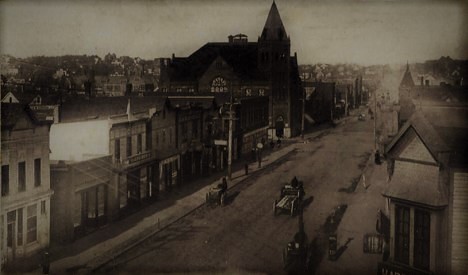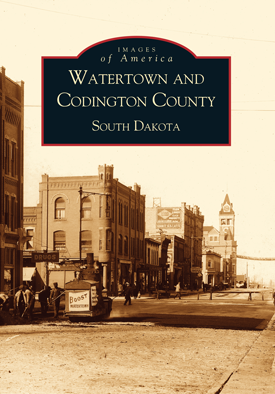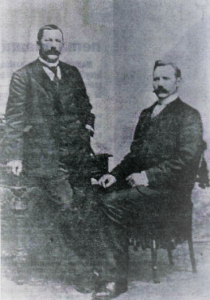
Aðalgata í St. Paul um aldamótin.
 Jón Stefánsson went to Minnesota with his brother, Guðmund, but together they had moved west in 1893, and Björg, their sister, was on the same trip. Guðmundur focused on teaching, but trade and business were on Jón’s mind. That’s why he sat down on a school bench in the capital St. Paul in Minnesota and studied commerce for two winters, 1894 to 1896. During the summer he was with Guðmundi near Marshall in Lyon County. He finished his studies and got a job in an office in Watertown, S. Dakota, and there he made a remarkable decision. He volunteered in the South Dakota Volunteer Infantry Regiment which was sent to the Philippines for the war that was raging there. He was a lieutenant and did well. Western Icelanders gave him the nickname Filippseyjakappi and it followed him in many places in America. The war was won and he was discharged and the regiment was sent back to S. Dakota. Jón subsequently decided to explore Asia, visiting Shanghai, Madras and Bombay. He sailed west through the Suez Canal into the Mediterranean, to England, Norway and Denmark before going to Iceland. He arrived there at the beginning of the year in 1900.
Jón Stefánsson went to Minnesota with his brother, Guðmund, but together they had moved west in 1893, and Björg, their sister, was on the same trip. Guðmundur focused on teaching, but trade and business were on Jón’s mind. That’s why he sat down on a school bench in the capital St. Paul in Minnesota and studied commerce for two winters, 1894 to 1896. During the summer he was with Guðmundi near Marshall in Lyon County. He finished his studies and got a job in an office in Watertown, S. Dakota, and there he made a remarkable decision. He volunteered in the South Dakota Volunteer Infantry Regiment which was sent to the Philippines for the war that was raging there. He was a lieutenant and did well. Western Icelanders gave him the nickname Filippseyjakappi and it followed him in many places in America. The war was won and he was discharged and the regiment was sent back to S. Dakota. Jón subsequently decided to explore Asia, visiting Shanghai, Madras and Bombay. He sailed west through the Suez Canal into the Mediterranean, to England, Norway and Denmark before going to Iceland. He arrived there at the beginning of the year in 1900.
Stay in Iceland 1900-1913

Stefán Th. Jónsson and Jón Stefánsson (seated) at Seyðisfjörður. Photo: Tíminn 1962.
He soon got a job in Reykjavík and became a guide for English tourists, but in the fall he went to Copenhagen to study at a trade school. After completing his studies, he went to Seyðisfjörður and was hired as the manager of the Pántunarfélag Fljótdalshérað in the town. He performed this job from 1902 to 1908. After that, he became a shipowner in Seyðisfjörður until 1913. During the years in Seyðisfjörður, he made his decision, and on October 22, 1904, he married Solveig Jónsdóttir, daughter of Jón Jónsson, member of the alþingi, from Múla in S. Þingeyjarsýslá and his wife, Valgerður Jónsdóttir. Jón’s parents in Múla were Jón Hinriksson at Helluváði in Mývatnsveit and his wife, Friðrika Helgadóttir. Valgerður’s parents were Jón Jónsson, district manager of Grænavatn and Kristbjörg Kristjánsdóttir. In the following years, Solveig gave birth to four children, Jón Múla, Stefán, Ragnar and Karl. The couple became involved in the town’s concerns, Jón was a town councilor for six years and Solveig for three.
Emigration and Coming West

Sparrows Point in Maryland
It can be assumed that the family had good years in Seyðisfjörður, available employment and the number of family members increasing. But something pulled at Jón, maybe he thought the conditions in the store and business were unreliable. It can be assumed that his brother and sister in the west wrote to him regularly and pointed him to various opportunities in the new province in Canada, Saskatchewan, to the west of Manitoba which became a province in Canada on September 1, 1905, and there began migration from Icelandic settlements in Manitoba, N. Dakota and Minnesota at the turn of the century. Jón accepted an offer for a general manager’s position at a granary in Saskatchewan and sailed west in 1913 and worked in Saskatchewan until 1918. He escaped to the west before the world war broke out in 1914, but Solveig stayed at home with the children until 1919. Jón was always vigilant about new opportunities in the West, and when he received an offer from a shipyard at Sparrows Point near Baltimore, Maryland, he jumped at the chance. He moved there, started work and prepared for the family’s arrival in Baltimore in the summer of 1919. He worked at the station until 1924 and during these years completed a degree in recoding at La Salle University and then worked for an insurance company in Baltimore, Maryland Casualty Co. During the last years of his career, he was a government employee, first in Washington D.C. and later in Baltimore.
English version by Thor group.
